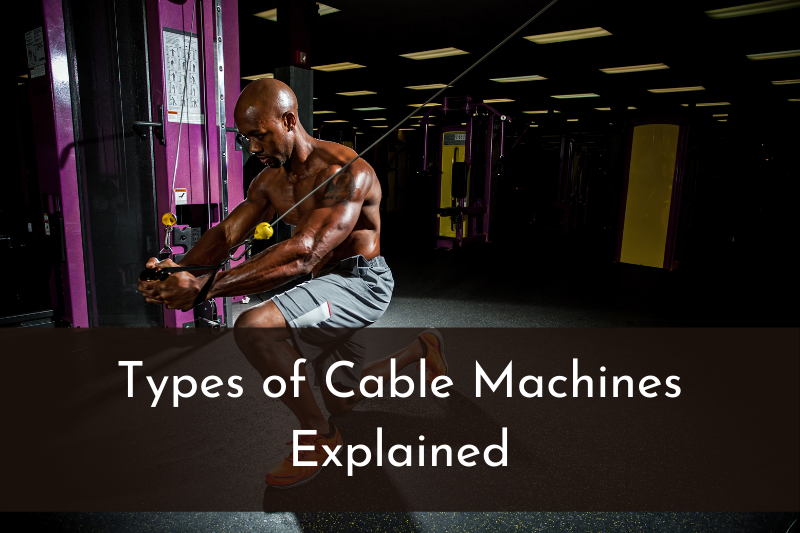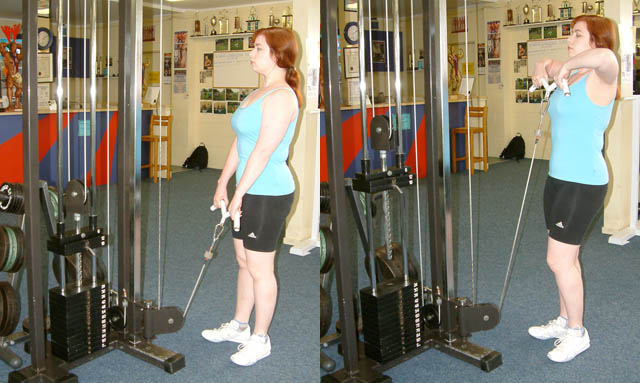
When you go to the gym, you have a ton of exercise options available to you in every area of the gym.
While everyone may gather around the cardio machines and free weights, you may notice one piece of equipment going neglected by most beginners: the cable machines.
Made of steel and capable of producing loud, clanging noises, cable machines, also known as pulley machines, can be great additions to your workout regimen — though they’re a little intimidating if you don’t know how to use them.
Once you get the hang of them and know how to implement cable workouts into your exercise regimen, you’ll be glad you did!
Here’s a guide to the different types of cable machines you’ll find at the gym and what they do, how to use them, and more.
Most cable machines at the gym can be broken down into two categories:
- single pulley
- and double pulley.
Single pulley machines feature a single cable attached to a weight stack — they’re ideal for two handed movements like a tricep pushdown or rope face pull.
Double pulley machines have two cables attached to the same weight stack, creating more leverage and lightening the load. Double pulley machines often, but not always, have two handles.
You’ll also see two single pulley machines placed close together — or a single large machine that features two separate weight stacks and pulleys. These are ideal for complex range of motion exercises like cable flys or overhead cable presses.
Lat pulldown machines and seated cable rowing machines are also considered cable machines — they’re just designed specifically for one type of exercise.
Let’s look at each type in closer detail.
What are cable machines & why use them? (Benefits)
A cable machine is a piece of equipment used for weight training.
It’s made up of a rectangular steel frame, and inside, you’ll find a weight stack attached via a cable (hence the name).
That cable is then attached to a handle — there are tons of attachments to choose from here, from simple handles, to ropes, to bars — which is what you operate.
Almost any exercise you could perform with barbells, dumbbells or other free weights — you can do with cable resistance.
Both cable machines and free weights are great for building muscles. However, free weights give you more variety.
Cable machines provide you with a very specific motion you have to perform to lift, so you’re explicitly targeting a certain muscle group with each rep.
There are several advantages to working out with cable machines as opposed to other types of weights, though. These include:
- Continuous tension: A major component of building muscle involves always having tension applied to the body. Cable machines make your muscles feel more fatigued faster, which is ultimately beneficial for larger gains.
- Safer range of motion: Cable machines often come with instructions showing you the proper way to use them. By following this, you ensure you’re moving the right way and decrease your chances of sustaining an injury, which has a greater likelihood with free weights.
- Isolation: When people go to the gym, they usually have an idea of what they want to work on. Whether you want to target your chest, arms, or shoulders, you can find pulley machines to work on the muscles you want.
There are some drawbacks and limitations to cable machines, though.
With free weights, you can really customize how much you lift down to a single pound.
Pulley machines generally allow you to increase the weight by around 20-pound increments, going up to maybe 300 pounds total.
If you want to lift any more than that, then you’re out of luck — though you can always choose a more difficult variation of body angle to increase difficulty.
However, for most people, cable machines will get the job done.
Single pulley vs. double pulley: What’s the difference?
There are two types of pulley machines you’ll typically come across at the gym: single and double.
Depending on what types of exercises you want to do, you’ll want to select a different one for your needs.
Single pulley

When a machine only has one pulley, it’s known as a “single pulley machine.”
Since there’s only one wheel and one pulley, you have to apply the full weight of the force.
If you want to lift 100 pounds, then you have to apply the full 100 pounds of force to move the weights. This results in a more intense workout for the muscles you’re trying to target.
Hannah Daugherty, an NASM- and ACE-certified personal trainer affiliated with Fitter Living, explains that the single pulley system is “more difficult than double systems, since the weight that you see on the stack is the weight you are actually lifting. Exercises like shoulder raises and oblique crunches are often done on single pulley systems.”
Single pulley machines are great for:
- Tricep pushdowns
- Rope face pulls
- Rope bicep curls
- Cable upright rows
- And more
Double pulley

As the name suggests, double pulley machines have two cables helping you lift the weights.
While the main benefit of this is that you can lift more weight, the downside is that you’re getting additional help — the double cable provides additional leverage.
Daugherty goes on to explain the drawback of this machine by stating, “Double pulley systems let one lift more weight in a shorter distance than a single cable machine. Whatever weight is selected with the pin, you’re only lifting half of it, which can be deceiving for beginners.”
For example, if you go to lift 100 pounds on a double pulley machine, your muscles are only getting the benefit of around 50 pounds of resistance.
This is why some people get confused about their performance in cable exercises — they seem to be able to lift way more or way less depending on what machine they use!
Single vs double pulley is the likely culprit.
Don’t confuse double pulley machines for a combination of two single pulley machines.
Many gyms have set ups that involve two different weight stacks, each with a single pulley, that you can use for movements like:
- Cable flys
- Cable overhead press
- Etc
Sometimes this is one big machine — sometimes it’s two single machines located close to each other.
In these cases, the weight selected on each stack corresponds directly to the amount of resistance you’ll feel in each handle.
Lat pulldown machines & seated cable row machines
In addition to the standard cable and pulley machines you’ll find at the gym, you’ll also see a few specialty cable-based machines.
The two primary ones most gyms have are the lat pulldown and the seated cable row.
Lat pulldown machine
A lat pulldown machine consists of a seat for you to get comfortable in with a bar overhead.
You grab the bar and pull down, mimicking the motion of doing a pull-up.
As you do this exercise, you’re bound to notice how it’s targeting your middle back and biceps.
This is due to the machine having compound exercise properties, requiring motion in two different joints (namely the elbows and shoulders).
To use this machine the right way, you want to make sure your feet are planted firmly on the floor.
Grip the overhead bar with your palms facing downward, ensuring your hands are about shoulder-width apart. Pull downward to where your upper arms are parallel to the ground.
Push the bar out and repeat the process for however many times you can until you push out with your chest to get the bar back in its original position.
There are various other exercises you can do on this machine to switch things up.
For instance, you can change the distance your hands are gripping the bar so that they’re further apart. You can also switch the hand position so that it’s parallel or supinated.
Seated cable row machine
A seated cable row machine basically re-enacts the motion you make with a rowing machine.
You pull the cord toward you, allowing you to work out your upper arm and back muscles.
The seat is located some distance away from the pulley.
Initially, you leave your arms outstretched with the handle in tow. You then pull it toward your chest, keeping your back straight the entire time.
You then return the handle under full tension to a full stretch, repeating as often as you can.
It’s recommended to start with a lighter weight initially.
You want to make sure you can perform smooth motions as pulling the cable the wrong way could injure your back.
Once you’re comfortable on the lower weights, you can gradually build up.
Like the lat pulldown, you can add different handles and attachments to the cable rowing machine including narrow handles, ropes, or bars.
Wrapping up
Cable machines are commonplace in pretty much every type of gym.
They’re extremely versatile and effective when used properly.
You’ll likely want to get the majority of your strength training with free weights (dumbbells and barbells, primarily) — but cables are an excellent supplement to help you target specific muscles and explore new ranges of motion.
Before you go, check out more guides to help you in the gym like:
- The different types of dumbbells
- The different parts of a barbell
- The different parts of a rowing machine
Hope this helps!